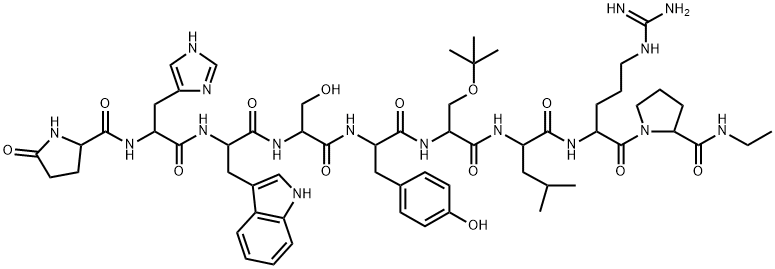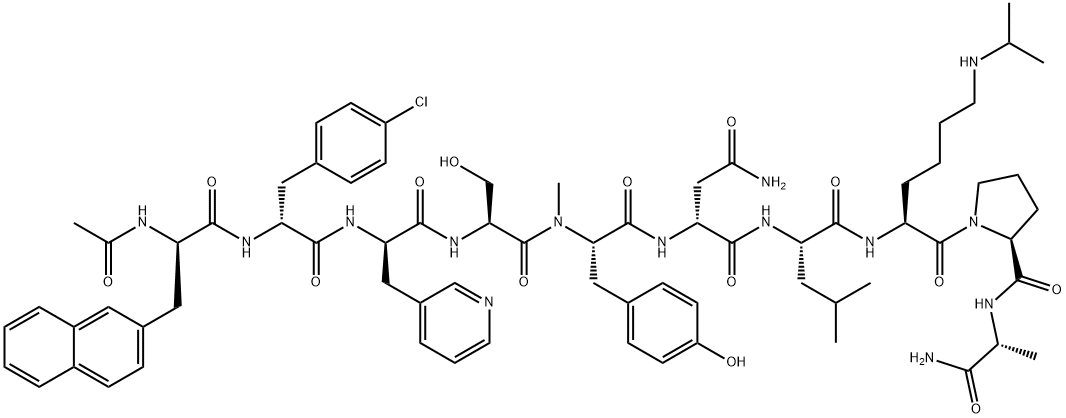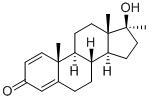BUSERELIN
- CAS NO.:57982-77-1
- Empirical Formula: C60H86N16O13
- Molecular Weight: 1239.42
- MDL number: MFCD00870371
- EINECS: 261-061-9
- SAFETY DATA SHEET (SDS)
- Update Date: 2023-11-24 16:35:22

What is BUSERELIN?
Absorption
Buserelin is water soluble and readily absorbed after subcutaneous injection (70% bioavailable). However, bioavailability after oral absorption. When administered correctly via the nasal route, it may be absorbed in the nasal mucosa to achieve sufficient plasma levels.
Toxicity
Buserelin may induce early, transient increase in serum testosterone or estradiol which can lead in the exacerbation of signs and symptoms of metastatic prostate cancer or endometriosis. Adverse reactions reported at more than 10% occurrence include headache, loss of libido in patients with prostate cancer, hot flashes, hypermenorrhea, decreased libido in prostate cancer and endometriosis, flatulence, impotence, vaginal dryness, back pain and nasal mucosa irritation.
Description
Buserelin (Suprefact?) is a hormonal therapy drug used to treat advanced prostate cancer. It is a medication which is used primarily in the treatment of prostate cancer and endometriosis. It is also used for other indications such as the treatment of premenopausal breast cancer, uterine fibroids, and early puberty, in assisted reproduction for female infertility, and as a part of transgender hormone therapy. In addition, buserelin is used in veterinary medicine. The medication is typically used as a nasal spray three times per day, but is also available for use as a solution or implant for injection into fat.
Chemical properties
White or slightly yellowish powder, hygroscopic.
The Uses of BUSERELIN
Gonad-stimulating principle.
Background
Buserelin is a synthetic peptide analog of the luteinizing hormone-releasing hormone (LHRH) agonist, which stimulates the pituitary gland's gonadotrophin-releasing hormone receptor (GnRHR). It is used in prostate cancer treatment.
Indications
Buserelin may be used in the treatment of hormone-responsive cancers such as prostate cancer or breast cancer, estrogen-dependent conditions (such as endometriosis or uterine fibroids), and in assisted reproduction.
Definition
ChEBI: Buserelin is an oligopeptide.
brand name
Suprefact (Hoechst-Roussel).
Pharmacokinetics
The substitution of glycine in position 6 by D-serine, and that of glycinamide in position 10 by ethylamide, leads to a nonapeptide with a greatly enhanced LHRH effect. The effects of buserelin on FSH and LH release are 20 to 170 times greater than those of LHRH. Buserelin also has a longer duration of action than natural LHRH. Investigations in healthy adult males and females have demonstrated that the increase in plasma LH and FSH levels persist for at least 7 hours and that a return to basal values requires about 24 hours. Clinical inhibition of gonadotropin release, and subsequent reduction of serum testosterone or estradiol to castration level, was found when large pharmacologic doses (50-500 mcg SC/day or 300-1200 mcg IN/day) were administered for periods greater than 1 to 3 months. Chronic administration of such doses of buserelin results in sustained inhibition of gonadotropin production, suppression of ovarian and testicular steroidogenesis and, ultimately, reduced circulating levels of gonadotropin and gonadal steroids. These effects form the basis for buserelin use in patients with hormone-dependent metastatic carcinoma of the prostate gland as well as in patients with endometriosis.
Clinical Use
Treatment of advanced prostate cancer and
endometriosis
Pituitary desensitisation in preparation for ovulation
induction regimens using gonadotrophins
Side Effects
Using too much Buserelin Injection may make you feel weak, nervous, dizzy and sick. You may also have a headache, hot flushes, stomach pain, swelling of the legs and breast pain. You may also have pain, bleeding or hardening of the skin at the site of injection
Metabolism
It is metabolized and subsequently inactivated by peptidase (pyroglutamyl peptidase and chymotrypsin-like endopeptidase) in the liver and kidneys as well as in the gastrointestinal tract. In the pituitary gland, it is inactivated by membrane-located enzymes.
Metabolism
Metabolic inactivation by peptides occurs in the liver and kidney. The drug is also inactivated by pituitary membrane enzymes. Excreted in the urine and bile as unchanged drug and metabolites.
Properties of BUSERELIN
| alpha | D20 -40.4° (c = 1 in dimethylacetamide) |
| Boiling point: | 845.19°C (rough estimate) |
| Density | 1.0711 (rough estimate) |
| refractive index | 1.6200 (estimate) |
| solubility | Sparingly soluble in water and in dilute acids. |
| form | Solid |
| pka | 9.82±0.15(Predicted) |
| color | White to Off-White |
| Stability: | Hygroscopic |
Safety information for BUSERELIN
| Signal word | Danger |
| Pictogram(s) |
 Exclamation Mark Irritant GHS07  Health Hazard GHS08 |
| GHS Hazard Statements |
H302:Acute toxicity,oral |
| Precautionary Statement Codes |
P308+P313:IF exposed or concerned: Get medical advice/attention. |
Computed Descriptors for BUSERELIN
| InChIKey | CUWODFFVMXJOKD-UHFFFAOYSA-N |
BUSERELIN manufacturer
Ralington Pharma
New Products
(S)-3-Aminobutanenitrile hydrochloride 4-Methylphenylacetic acid N-Boc-D-alaninol N-BOC-D/L-ALANINOL Tert-butyl bis(2-chloroethyl)carbamate 3-Morpholino-1-(4-nitrophenyl)-5,6-dihydropyridin- 2(1H)-one Furan-2,5-Dicarboxylic Acid Tropic acid 1-Bromo-3,5-Di-Tert-Butylbenzene S-2-CHLORO PROPIONIC ACID ETHYL ISOCYANOACETATE 2-Bromo-1,3-Bis(Dimethylamino)Trimethinium Hexafluorophosphate 4-IODO BENZOIC ACID 3-NITRO-2-METHYL ANILINE 1-(2,4-DICHLOROPHENYL) ETHANAMINE (2-Hydroxyphenyl)acetonitrile 4-Bromopyrazole 2-(Cyanocyclohexyl)acetic acid 4-methoxy-3,5-dinitropyridine 1-(4-(aminomethyl)benzyl)urea hydrochloride 2-aminopropyl benzoate hydrochloride diethyl 2-(2-((tertbutoxycarbonyl)amino) ethyl)malonate tert-butyl 4- (ureidomethyl)benzylcarbamate Ethyl-2-chloro((4-methoxyphenyl)hydrazono)acetateRelated products of tetrahydrofuran
You may like
-
 57982-77-1 Buserelin 98%View Details
57982-77-1 Buserelin 98%View Details
57982-77-1 -
 2033-24-1 98%View Details
2033-24-1 98%View Details
2033-24-1 -
 1975-50-4 98%View Details
1975-50-4 98%View Details
1975-50-4 -
 2-HYDROXY BENZYL ALCOHOL 98%View Details
2-HYDROXY BENZYL ALCOHOL 98%View Details
90-01-7 -
 2-Chloro-1,3-Bis(Dimethylamino)Trimethinium Hexafluorophosphate 221615-75-4 98%View Details
2-Chloro-1,3-Bis(Dimethylamino)Trimethinium Hexafluorophosphate 221615-75-4 98%View Details
221615-75-4 -
 61397-56-6 CIS BROMO BENZOATE 98%View Details
61397-56-6 CIS BROMO BENZOATE 98%View Details
61397-56-6 -
 14714-50-2 (2-Hydroxyphenyl)acetonitrile 98+View Details
14714-50-2 (2-Hydroxyphenyl)acetonitrile 98+View Details
14714-50-2 -
 118753-70-1 98+View Details
118753-70-1 98+View Details
118753-70-1







